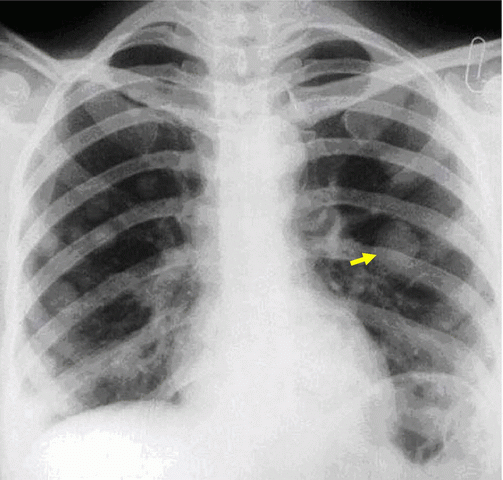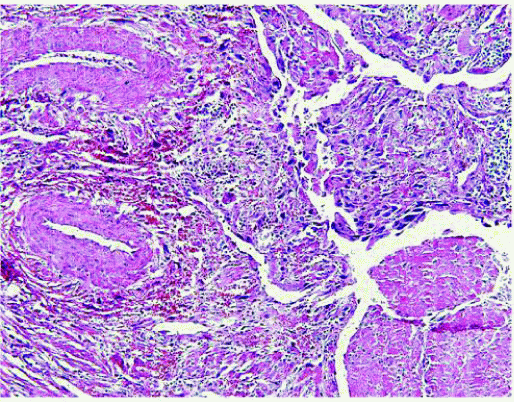International Journal of Biomedical Science
4(1), 74-77, Mar 15, 2008
© 2005 Master Publishing Group
Early Onset of Metastatic Gestational Trophoblastic Disease after Full-Term Pregnancy
Fatemeh Ghaemmaghami1, Mojgan Karimi Zarchi2
1 Tehran University of Medical Sciences, Tehran, Iran
2 Department of Gynecologic oncology, Vali-e-Asr Hospital, Imam Khomeini Oncology Complex, Tehran, Iran
Corresponding Author: Mojgan Karimi Zarchi, Department of Gynecologic oncology, Vali-e-Asr Hospital, Imam Khomeini Oncology Complex, Tehran 14194, Iran. Tel: 98-21-6693 9320; Fax: 98-21-66937321; E-mail: drkarimi2001@yahoo.com.
|
|
ABSTRACT
 |
Choriocarcinoma is a curable malignancy that occurred approximately 50% after term pregnancies, and prognosis in this form of gestational trophoblastic Disease (GTD) is Poor. The earliest onset choriocarcinoma after term pregnancy in one study was reported 3 weeks after delivery, but in current study, choriocarcinoma was diagnosed 2 weeks after delivery. 28 years-old women gravidity 2, parity 2 delivered a healthy infant at term. Frequent episodes of vaginal bleeding occurred after 10 days of delivery. On admission to hospital, she had lesions in the lungs. The pretreatment human chorionic gonadotropin (HCG) level was 84,000 mIU/ml and her FIGO risk factor score was 8 (high risk group). The EMA/CO regimen was administered as first line chemotherapy and the patient achieved complete remission after 7 courses. Although early onset postpartum hemorrhage is due to complication of delivery, but gestational trophoblastic disease (GTD) may be occurred and assessment of human chorionic gonadotropin could be help to early diagnose of GTD.
KEY WORDS:
GTD, Choriocarcinoma, vaginal bleeding after delivery, EMA/CO
|
|
INTRODUCTION |
Gestational Trophoblastic Disease (GTD) represents a variety of conditions that include hydatiform mole, invasive mole, choriocarcinoma and Placental Site Trophoblastic Tumor (PSTT). Choriocarcinoma is a rare trophoblastic tumor, which was curable and may be developing after any gestational events. Choriocarcinoma occurred approximately 50% after term pregnancies, 25% after molar pregnancies and the reminder after other gestational events (1-3). Choriocarcinoma follows a normal term pregnancy in 1 per 150000-160000 normal pregnancies and it is associated with an unfavorable outcome. GTD after a normal pregnancy is always choriocarcinoma. (1-4) Choriocarcinoma invades and metastasis early and is often widespread at the time of diagnosis. Presently signs and symptoms of gestational choiocarcinoma are highly variable in patients with GTD, gynecological symptoms are sometime ignored, attributed to normal peripartum or vaginal bleeding in puerperium or may be presented by non classic manifestation (1-3). Multiple studies have been reported about choriocarcinoma after term pregnancy (table 1). Berkowitz reported that incidence of choriocarcinoma after term delivery was 4.1% of 366 case of GTD. Post term
gestation choriocarcinoma has a propensity for more extensive metastatic spread particular liver and brain and remission rate in patients to conventional chemotherapy was lower than other forms of GTD (Remission rate=61.5%) (3). Miller has reported that poor prognostic factors in choriocarcinoma after term delivery included:
Initial human chorionic gonadotropin titer of greater than 100,000 IU/24h;
Interval >4 month between termination of pregnancy to initial treatment;
Previous failure chemotherapy;
Brain or liver metastasis.
He also reported that response rate in choriocarcinoma after term delivery to be less than other forms of GTD (4). Also if interval from index pregnancy to initial treatment to be less than 4 month, remission rate was 87.5%. He added, in post-term metastatic choriocarcinoma should be initiated combination chemotherapy and in special cases, surgery or radiotherapy was benefit. Lurain (5) had reported that remission rate in metastatic choriocarcinoma after term delivery was 50% VS 75% in other forms of GTD. Number of risk factors is important, for example: if only one or two risk factor is available, survival rate was 74%, but if 3 or 4 risk factor is available, this rate was 27%.
View this table:
[in a new window]
|
Table1 case report of post term delivery choriocarcinoma.
| |
|
|
CASE
 |
A 28-years-old woman (gravida 2, parity2) who had delivered 3,200g female infant on October, 2005. The placenta was macroscopically normal. The patient had vaginal bleeding greatrer than normal patients 10 days after delivery. Laboratory evaluation was a titer of 55,000 miu/ml in HCG. Pelvic ultrasound examination revealed a 12×9×8 cm uterus with a thick endometrial line. Due to high level of HCG titer & persistent bleeding, curettage was performed 2 weeks after delivery that established degenerative tissue. But her bleeding had increased after D&C and HCG had raised (to 84,000 miu/ml) .In her chest radiography had diagnosed metastatic nodules (fig. 1) and in lung CT scan revealed multiple bilateral pulmonary nodules. Due to sever bleeding, she was underwent total abdominal hysterectomy in 7 weeks after delivery for life saving and her pathology was choriocarcinoma (fig. 2). The titrage of HCG after surgery was 83,000 miu/ml. According to the FIGO scoring system by the WHO, the patient score was 8(high risk group) and her stage was III, then she was underwent combination chemotherapy with EMA/CO regimens (Etoposide + Metotrexate (MTX)+Actinomycin-d +cyclophosphamid+vincristin). At this time she had received 5 course of EMA/CO regimen and 2 courses for consalidation therapy were performed after complete remission currently. HCG titer decreased and was negative after 3 courses and the patient received 2 courses after normal range of HCG titer.

View larger version :
[in a new window] |
Figure 1: The appearance of lung metastasis in patient that was reported.
| |

View larger version :
[in a new window] |
Figure 2: The microscopic appearance of choriocarcinoma in this patient.
| |
 DISCUSSION DISCUSSION

|
Although the most common cause of post partum hemorrhage is complication of delivery, but should be remember that GTD may be occurred. In previous studies early onset metastatic choriocarcinoma after term pregnancy was 6 months, 11 weeks and 3 weeks, but in current study GTD after 2 weeks of delivery was diagnosed. Also all patients in these reports had lung metastasis (7-9).Prognosis of metastatic choriocarcinoma after term pregnancy is generally poor. Due to early extensive spread of disease and responsiveness to chemotherapy and change in the host immune response or a delayed diagnosis (4-6). The patients with metastatic choriocarcinoma shouldn’t be underwent biopsy of metastasis, due to increased risk of hemorrhage of metastasis (2-3).The other forms of GTD after term pregnancy is Placental Site Trophoblastic Tumor (PSTT) that has occurred approximately in 53-78% after term pregnancy. Vaginal bleeding or amenorrhea has seen in always of patients with PSTT .The different diagnosis of post-term choriocarcinoma and PSTT is level of BHCG, because in PSTT measure of HCG is lower than choriocarcinoma (9).In many of studies interval of disappearance of HCG after delivery is variable and mean of this time is 3 weeks (10).Remission rate in metastatic post-term gestational choriocarcinoma is lower than this after other forms of pregnancy (7-10).A Many of combination chemotherapy regimens had treated in choriocarcinoma, that includes: EMA/CO regimens include Etoposide + Metotrexate (MTX)+Actinomycin-d +cyclophosphamid+vincristin . Cure rate with MAC regimen in first line treatment was 51% VS 30% in second line treatment. Complete remission was seen with CHAMOCA regimen in patients that resistance to MAC, but this regimen is one protocol with high toxicity (5). In previous studies was shown that etoposide not only has effective in first line treatment, but also in recurrence of GTD (12). Also taxans has shown that has effective in recurrence cases. Without lower limit of tumoral cells that has diagnosed one titer of HCG for early diagnosed, is 10000 cells, thus some of authors had relieved that should be Continued 3 course of chemotherapy as consolidation therapy and some of they had commented that treatment should be continued to one negative titrage of HCG. Importantly, recurrence may be had seen many age after complete remission of GTN. Overall recurrence rate with EMA/CO: approximately 11-19% had reported (2).Well defined that response rate to secondary chemotherapy is poor, thus has recommended early treatment has selected well (9-12).We have thought that EMA/CO regimen should be selected as first line in always of patients with high risk GTD, because response rate is good and tolerance is Sufficient.
|
|
REFERENCES
 |
- John T. Soper, David G. Mutch, and julian C. Schink for the American collage of obstetrics and gynecologist, Diagnosis and treatment of gestational trophoblastic disease: ACOG practice Bulletin No. 53, Gynecologic Oncology. 2004; 93: 575-585.
-
New lands ES, the management of recurrent and during resistant gestational trophoblastic neoplasia (GTN): Best Prac Res Clin Obstet Gyneco.l 2003; 17 (6): 905-923.
-
Berkowitz RS. Goldstein OP. Gestational trophoblastic neoplasia, Berek JS, Hacker NE, practical Gynecologic oncology. 4 ed Williams & Wilkins. 2005; p. 603-625.
-
Miller JM, JR, Surwith EA, Hammond CB. Chriocarcinoma following term pregnancy. Obstet Gynecol. 1979; Feb: 53(2): 207-12.
-
Lurain JR and Brewerji. Treatment of high-risk gestational trophoblastic disease with methotrexate, actinomaycin and cyclophosphamide chemotherapy, obstet Gynecol. 1985; 65: 830-836.
-
Farley, John H. MD, Hathcock, R. Brian MD, et al. Treatment of metastatic gestational choriocarcinoma with oral methotrexate in a combat environment (case report). The American college of obstetrics and gynecologist. volume 105 (5 part 2) supplement. May 2005; pp 1250-1254.
-
Flam F, Choriocarcinoma in the term placentas, a difficult diagnosis, Eur J Gynecol oncol. 1996; 17(6): 510-1.
-
Yuji Hiramatsu, Hisashi Masuyema, Makoto Ishida, Kazutharu Murakami, and Masaru satarai. Term delivery choriocarcinoma patient with brain and lung metastases successfully treated by etoposide, mothotrexate, actinomycin D, Cyclophosphamid and Vincristin (EMA-co) chemotherapy. Acta Medokayoma. 2005; vol 59 No. 5, pp 235-238.
-
Colleen M, Fettmate MD, David R et al. Placental site trophoblastic tumor: a 17 year experience at the new England trophoblastic disease center: Gynecologic oncology. 2001; 82: 415-418.
-
Korhonen Juha, Alftha Henrik. Disappearance of Human chorionic gonadotropin and its and B-subunits after term pregnancy. Clinical chemistry .1997; 43: 2155-2159.
-
Jushua AM, Carter JR and Beale P: The use of taxanes in choriocarcinoma a case report and review of the literature. Gynecol Oncol. 2004; 94: 581-583.
-
Newland ES, Bagsh KD, Begent RH, Rusin GJ. Holden L and Dewt J, Developments in chemotherapy for medium and high risk patients with gestational trophoblastic tumor (1979- 1984). Br J obstet Gynecol .1986; 93: 63-69.